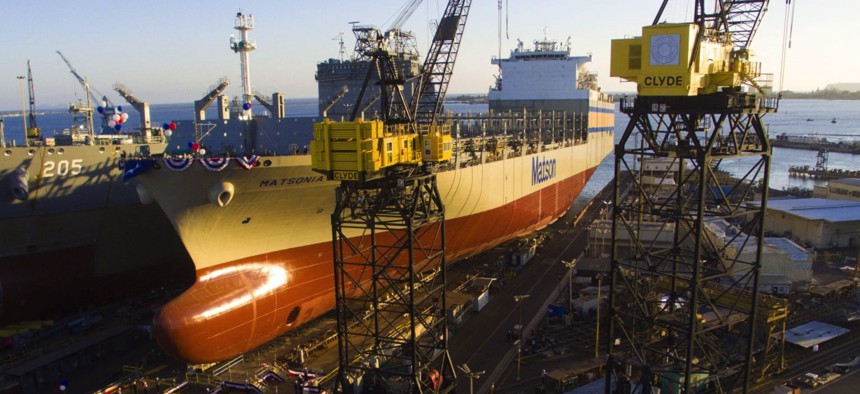
The Kanalao-class “con-ro” ship Matsonia was launched at GD's NASSCO shipyard in July 2020. MATSON
Preserve the Jones Act
China’s burgeoning fleets underscore the importance of legislation that bolsters our own.
As we pass the 100th anniversary of the Jones Act, it is clear the legislation is vital to ensuring the American maritime industry is strong for 100 years more. Officially known as the Merchant Marine Act of 1920, the law requires that ships carrying cargo between two U.S. points fly the U.S. flag, and be owned and built in the U.S., and be crewed by at least 75 percent U.S. citizens. Although many nations have such laws, known as “cabotage” laws, it is true that ours is among the most restrictive. However, this is necessary given the amount of support other maritime nations give to an industry rightly established as vital to their nation’s economic security and defense. These are the findings of the Navy League’s newest report, “China’s Use of Maritime for Global Power Demands a Strong Commitment to American Maritime.”
While the heated debate over the policy has traditionally been confined to small circles, it came under the national spotlight after Hurricane Maria devastated the island of Puerto Rico, and the lives of the millions of Americans living there. As relief efforts slowly got underway after the Sept. 20, 2017, storm, critics cited the Jones Act as an impediment to the swift delivery of much-needed supplies to the beleaguered island. (They also trotted out old arguments that the Act constrains shipping and leads to high consumer prices on the island, assertions that the Government Accountability Office has found little evidence to support.) On Sept. 28, the president issued a 10-day waiver to the Act, allowing foreign-flagged ships to carry supplies to Puerto Rico from other U.S. ports. Almost a month later just 11 foreign ships had made the run. Jones Act carriers added nine vessels to their Puerto Rico routes after the hurricane to total 25, with one carrier making nearly daily sailings from the mainland. Indeed, containers arrived faster than Puerto Rico’s internal distribution system could handle them, stacking up by the hundreds in port and showing that shipping capacity was not the main problem.
Free-trade purists oppose the Jones Act as government intervention in the free market. However, this critique of shipping rules ignores the heavy intervention of other governments in their domestic maritime industries. The Chinese state spent $132 billion, conservatively, on its shipping and shipbuilding industries between 2010 and 2018, according to the Center for Strategic and International Studies. The only U.S. government agency supporting the maritime industry had less than a $1 billion budget for 2020, with outstanding loans totaled more than twice that amount.
And while critics argue we should take advantage of “savings” their subsidized ships operating with government subsidies would provide, they ignore the devastating damage that the loss of Jones Act shipping and U.S. shipyards would wreak on our national defense and economic security. These critics might instead start by advocating China move first to eliminate its protectionist laws and state intervention. And if critics insist on eliminating our cabotage law, would they advocate for our shipbuilding industry to receive as many billions of dollars in direct and indirect subsidies as the largest shipbuilders in China, Japan, and South Korea?
Some critics also miss a primary reason for the passage of the Jones Act: to retain a domestic shipbuilding industry that can mobilize for war or other national emergency. That’s why it is supported by leaders of the Navy, DoD, Transportation Command, Maritime Administration, and Department of Transportation. Yet the Competitive Enterprise Institute argues the Jones Act is merely “political influence for profit,” which is quite an assertion coming from a climate-denying think tank substantially funded by the oil and gas industries, longtime opponents of the Jones Act who believe it hurts their profits.
Then there is the argument that Jones Act shipbuilders do not overlap with Navy shipbuilders. That would be a surprise to San Diego’s NASSCO, which has built dozens of Navy Combat Logistics Force ships, as well as Louisiana’s Bollinger, Wisconsin’s Marinette, and Alabama’s Austal USA. In addition to these final assemblers, thousands of second and third tier suppliers contribute to both the military and Jones Act shipbuilding trades. Additionally, MARAD estimates we have a shortage of 1,800 mariners to sustain extended logistics operations. Since Jones Act ships make up 60 percent of the total ocean-going U.S.-flag fleet and employ an equivalent percentage of mariners, how do the law’s critics think we will be able to activate and crew the Maritime Administration’s and Navy’s surge sealift ships if these Jones Act ships disappear?
Yes, the Jones Act may mean slightly higher shipping costs to some major corporations, but it is important to look at the bigger picture. It might cost slightly more, but we pay for the best-run ships, and best mariners in the world working tough jobs.



